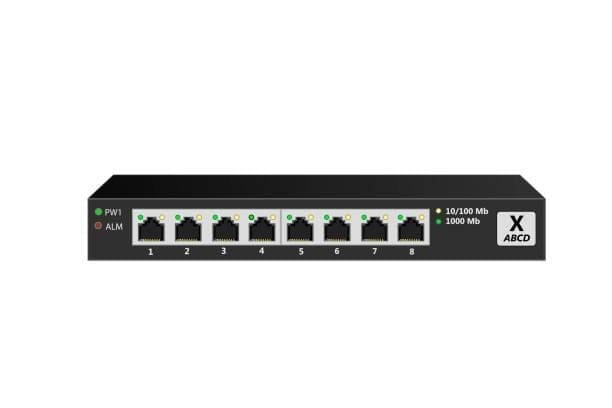Networking devices like routers, switches, and hubs are crucial in connecting computers and other devices on local area networks and enabling communication between them.
Of these, ethernet switches have become an essential component of modern networks, facilitating faster and more efficient data transmission. But what exactly are ethernet switches, and how do they function differently than other networking hardware?
This guide will explain what ethernet switches are, how they function as traffic controllers to determine the most efficient data transfer path between connected devices, and the key benefits they provide over other networking hardware.
What is an Ethernet Switch?
An Ethernet switch is a core networking device that connects multiple devices under a local area network (LAN). It acts as a traffic controller for data flowing across a network. An Ethernet switch allows for full-duplex transmission of data, enabling simultaneous communication in both directions.
Like other switch infrastructures, an Ethernet switch is used to link Ethernet devices from one device on the data network using Ethernet frames.
Today, industrial Ethernet switches are tailored and designed to be used everywhere regardless of environment, allowing you to build cost-effective, secure and reliable networks.
Reputable brands such as Larch Networks are able to solve your communication tasks with their various switches. Its industrial switches connect up to nine devices, rendering it an excellent choice for surveillance and intelligent transport systems.
How Does an Ethernet Switch Work?
An Ethernet switch has multiple ports that can be used to connect various devices, such as printers, computers, servers, and more. Each device connected to the switch is spotted by a unique Media Access Control (MAC) address assigned to its network interface card (NIC).
When a device redirects data over the network, the switch establishes the destination MAC address of the data frame before determining which port to forward it to. If the destination MAC address corresponds to a device connected to the same switch port as the sending device, the switch will block the frame from going out to the rest of the network and transmit it only to the intended recipient. This filtering helps reduce traffic and collisions on the network.
The switch builds a MAC address table by examining the source MAC address of each incoming data frame. This table associates the MAC addresses with the switch port they connect to. By referring to the MAC address table, the switch can check the destination MAC address of an outgoing frame and immediately forward it out to the correct port.
If the destination MAC address is not found in the table, indicating the recipient device is connected to another switch port, the frame is flooded out to all ports (except the originating port). When the intended recipient device responds, its MAC address is added to the table, allowing future frames to be forwarded only to that device.
The MAC address table is dynamically updated as devices join, leave or move across ports.
Switching Methods
Ethernet switches use one of three main switching methods:
- Store-and-forward switching: The switch waits to receive the entire frame before checking the cyclic redundancy check (CRC) for errors. If the frame is good, it gets forwarded to the proper port based on the destination MAC address. If bad, the frame is dropped.
- Cut-through switching: The switch starts forwarding a frame immediately after reading the destination address without checking for CRC errors first. This latency reduction comes at the risk of forwarding bad frames.
- Fragment-free switching: This is a hybrid approach where the switch waits until the first 64 bytes of the frame are received before forwarding, thus checking for CRC errors of the frame header, but not the full payload.
Benefits of Using an Ethernet Switch
There are several key benefits to using an Ethernet switch versus a hub for a local area network:
- Increased bandwidth – Full-duplex communication doubles the bandwidth for each switch port. Aggregating links or using higher-speed ports also expands capacity.
- Enhanced security – Traffic is only forwarded to the intended recipients rather than broadcast to all connected devices. VLANs add further segmentation.
- Flexibility – Among the technical New devices can be added without impacting existing ones. More ports can be added via link aggregation or stacking switches.
- Improved performance – A switch provides a direct connection between source and destination. Frames are forwarded immediately rather than queued for shared access like with a hub.
- Reliability – Features like spanning trees prevent network loops and provide redundancy. Switches are not impacted by a single failing port.
Key Switch Components
- ASIC or CPU: The application-specific integrated circuit (ASIC) or central processing unit (CPU) handles the switching logic, VLAN configuration, filtering, and monitoring.
- RAM: Buffers temporarily store data frames while they are processed and forwarded. RAM also supports the MAC address table.
- Flash memory: Stores the switch’s operating system, configuration files, and software updates.
- Ports: Physical ports like twisted-pair copper (RJ45), fiber optic, or SFP+ slots that connect outgoing and incoming network cables. Port speed options include 10Mbps, 100Mbps, 1Gbps, and more.
By leveraging these advanced capabilities, network admins gain broader oversight and control over their LAN infrastructure.
Conclusion
For modern networks, Ethernet switches are essential for taking full advantage of bandwidth capabilities, securely segmenting traffic, avoiding congestion, and simplifying scalability as networks grow. Their performance, flexibility, and security make Ethernet switches the backbone of modern LANs.
Therefore, ensure you get an Ethernet switch for your organization to allow you to build reliable and cost-effective networks.

